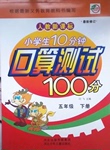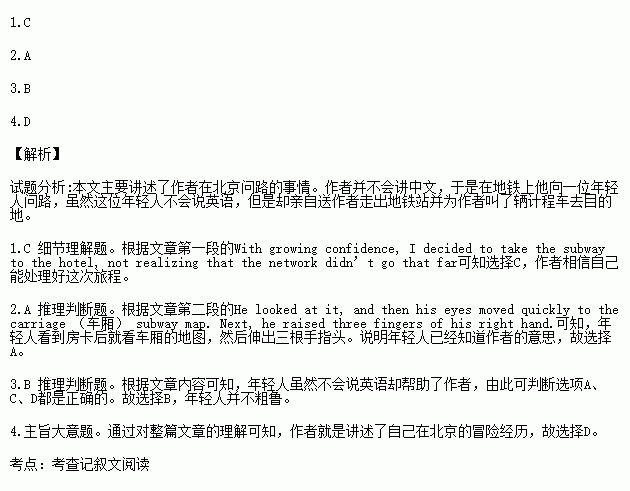题目内容
After I made it to the city center, I started to feel it might be easy for a foreigner to deal with the great size of Beijing. With growing confidence, I decided to take the subway to the hotel, not realizing that the network didn’t go that far. Impressed with the cleanliness of the station, I bought a ticket and boarded the first train that came along.
After a few minutes I asked in English of course a young man seated next to me where I should get off closest to the Friendship Hotel. Wearing a smart business suit and tie, he would surely speak English, wouldn’t he? Unfortunately, he couldn’t understand me but seemed very friendly. I showed him the room card with all the information of the Friendship Hotel in Chinese characters. He looked at it, and then his eyes moved quickly to the carriage (车厢) subway map. Next, he raised three fingers of his right hand.
In Australia, raising fingers at someone is not usually nice, but this man wasn’t smiling. At the next station he showed me two fingers. Now in Australia, that’s really rude, but I got the message. When we stopped at the third station, he didn’t just point to the door, but got up, took me out of the train, and led me to the top of the stairs, and out onto the street. Then he stopped a taxi and told the driver where to take me.
All this came from a man who couldn’t speak my language, and I couldn’t speak his. I was now speechless, especially when he refused my offer of money. I felt a little embarrassed having even thought he would accept a tip.
This experience made it clear I had to learn some Chinese quickly or my adventures might start turning into bad luck.
1.The author decided to take the subway because ________.
A.he lived near the city center
B.the network covered most of the stops
C.he believed in his ability to deal with the trip
D.he had a good impression of its cleanliness
2.Having been shown the room card, the young man_________.
A.understood the author well
B.still remained puzzled
C.answered the author directly
D.pointed at the subway map
3.Which of the following can’t be used to describe the young man?
A.helpful B.rude
C.warmhearted D.caring
4.The author’s purpose of writing this passage is mainly to ________.
A.prove the importance of being careful
B.appreciate the kindness of the young man
C.complain some cultural misunderstanding
D.describe one of his adventurous experiences
 小学生10分钟口算测试100分系列答案
小学生10分钟口算测试100分系列答案假如你是李华,你的笔友Tom发来电子邮件询问你的音乐喜好和你在新年晚会上的表现。请你给他写封电子邮件,回答他的所有问题。
Dear Li Hua, From your last e-mail, I am glad to know you like music and performed at the New Year Party. I am eager to know what kind of music you like and dislike best and why. And since you are so busy with your studies, I want to know when and how you listen to music. Besides, at the New Year Party, did you sing or play a musical instrument? Is it a success? Looking forward to your reply. Yours, Tom |
注意:1.词数100左右;
2.可以适当增加细节,以使行文连贯;
3.信的抬头与结尾已为你写好,但不计入总词数。
Hi, Tom,
As you know, I’m music mad. _______________________________________________
____________________________________________________________________________
____________________________________________________________________________
By the way, do you love music as well?

